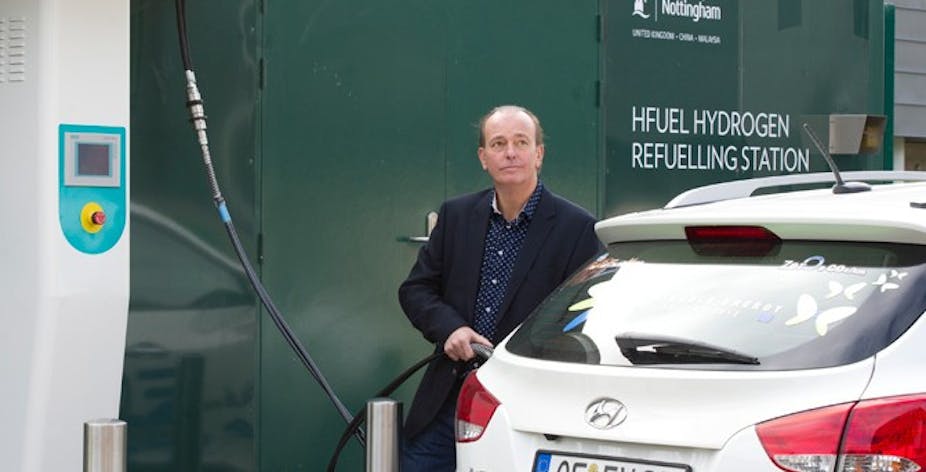The promise that hydrogen cars would help reduce carbon dioxide emissions from the transport sector has been with us for a couple of decades. Readers may well have wondered what, like hoverboards, has happened to these inventions, and why they’re not driving round our streets.
The city of Copenhagen recently announced it had rolled out a fleet of 15 Hyundai ix35 hydrogen fuel cell electric vehicles (FCEV), while in the UK the same car has been driving around the University of Nottingham, which has a new ITM Power HFuel hydrogen fuelling station. So at least hydrogen cars, unlike Marty McFly’s hoverboard, aren’t just a figment of our imaginations.
Believe it or not the very first spark-ignition, internal combustion engine-powered vehicle was built as far back as 1807 by the Swiss inventor, Isaac de Rivaz - and it ran on hydrogen. This was not well received at the time, as it was not seen as competitive compared to the new steam engine technology. The first fuel cell was demonstrated by Sir William Robert Grove in 1839, but it took another 100 years before a 5kW fuel cell was successfully developed, by Francis Thomas Bacon and was only suitable for stationary applications.
Hydrogen power works by reacting hydrogen and oxygen together in an electrochemical fuel cell to produce an electric current (which can drive a motor) and water. A big difference between a fuel cell and battery is that a fuel cell needs only to be re-filled with hydrogen, like a petrol tank, whereas a rechargeable battery needs to be plugged into a power supply and recharged - which can take hours.
Hydrogen fuel cell efficiency can be greater than 50%, but a problem with using them in cars has been size and cost. The first compact hydrogen fuel cells able to fit in a car were not developed until the mid 1990s. An early example of a FCEV is the Mazda Demio, which stored hydrogen in a metal hydride and was powered by a 20kW fuel cell. In comparison, the new Hyundai ix35 FCEV has a 700 bar compressed gas storage tank and is powered by a 100kW fuel cell.
What’s great about hydrogen is that it contains a lot of energy by volume - it’s volumetric energy density is high.

Hydrogen fuel cells can provide 400 Watt-hours per litre (Wh/l) - which is twice that for Lithium-ion batteries, and much more than other battery types like NiMH. So a hydrogen car with 5kg of hydrogen in the tank would have a 205-litre fuel cell system - to provide the same by battery power, it would mean filling an extra 200 litres of space in the cabin or boot with batteries. So a more energy-dense fuel means more can be carried, giving the vehicle a greater range between refuelling stops.
The common perception that hydrogen cars compete against battery cars is really illusory - the technologies complement each other.
Another barrier that hydrogen cars face in trying to break into the market is cost. The polymer electrolyte membrane (PEM) fuel cells need platinum to speed up the chemical reaction of the hydrogen gas, and reducing this amount has obviously led to a dramatic drop in cost. Results from the US Department of Energy programme for the projected high volume manufacturing costs of PEM fuel cells have shown a drop from $275 per kW down to $49 per kW between 2002 and 2011. This is getting very close to the department’s 2017 target of $30 per kW for hydrogen cars, deemed to be the threshold for commercial viability.
An important means to reduce cost is volume production - there can be significant reduction in cost just through efficiency of scale. It’s been estimated that the fuel cell system costs drop by up to 70% just from increasing numbers manufactured from tens to thousands. To put that into context, those Hydundai cars now on the streets of Copenhagen retail for around £130,000 each. As the first production line hydrogen car, Hyundai are in a good position to capitalise on this economy of scale, helping to bring the cost down to a figure more comparable to a diesel vehicle.
The prospect for a market for hydrogen cars is looking very promising - huge improvements in the fuel cell performance and significant cost reductions. The joint government-industry project UKH2Mobility has estimated that annual sales of hydrogen cars in the UK could reach 10,000 by 2020 as the cost approaches that of diesel vehicles.
Sounds like it’s not just optimists and inventors who think hydrogen cars are coming, and that it won’t be long before we’re driving into the future - lets just hope hydrogen filling stations are not as rare as hoverboards.

